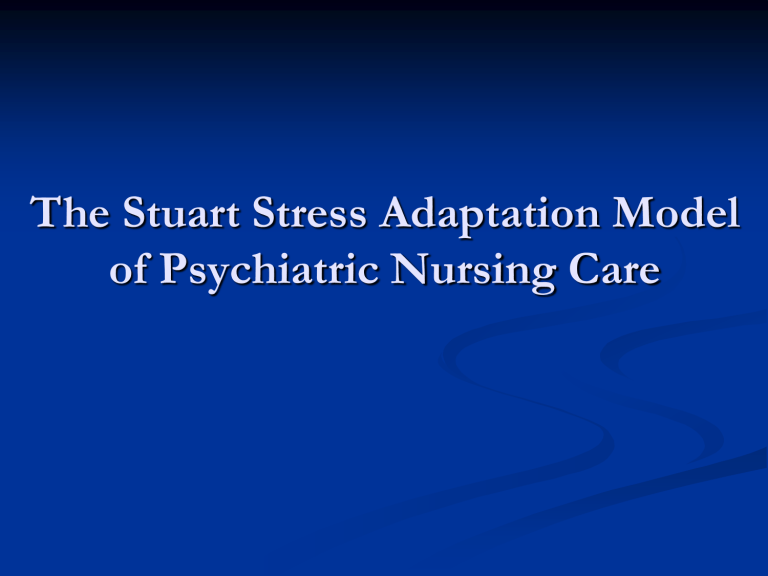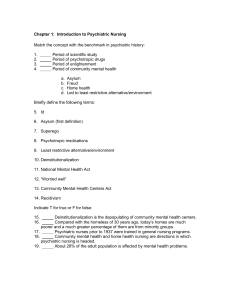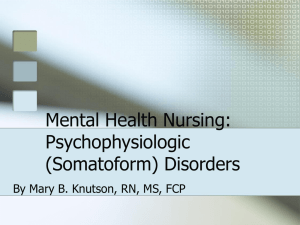Stuart Stress Adaptation Model: Psychiatric Nursing Care

The Stuart Stress Adaptation Model of Psychiatric Nursing Care
Models provide a structure for thinking, observing, and interpreting what is seen.
Conceptual nursing models are frames of reference within which patients, their environment and health states, and nursing activities are described.
This textbook is based on the Stuart Stress
Adaptation Model of psychiatric nursing care, which integrates biological, psychological, sociocultural, environmental, and legal-ethical aspects of patient care into a unified framework for practice.
Theoretical Assumptions:
The first assumption of the Stuart Stress
Adaptation Model is that nature is ordered as a social hierarchy from the simplest unit to the most complex. Each level also is a part of the next higher level, so nothing exists in isolation.
Thus the individual is a part of family, group, community, society, and the larger biosphere.
The second assumption of the model is that nursing care is provided within a biological, psychological, sociocultural, environmental, and legal-ethical context.
The nurse must understand each of them in order to provide competent, holistic psychiatric nursing care.
The theoretical basis for psychiatric nursing practice is derived from nursing science as well as from the behavioral, social, and biological sciences.
This means that a person with a medically diagnosed illness may be adapting well to it. An example of this is the adaptive coping responses used by some people who have chronic physical or psychiatric illnesses. In contrast, a person without a medically diagnosed illness may have many maladaptive coping responses. These two continuums thus reflect the complementary nature of the nursing and medical models of practice.
The fourth assumption is that the model includes the primary, secondary, and tertiary levels of prevention by describing four discrete stages of psychiatric treatment: crisis, acute, maintenance, and health
promotion. For each stage of treatment the model suggest a treatment goal, a focus of the nursing assessment, the nature of nursing interventions, and the expected outcome of nursing care.
The fifth assumption of the Stuart Stress
Adaptation Model is that it is based on the use of the nursing process and the standards of care and professional performance for
psychiatric nurses. Psychiatric nursing care is provided through assessment, diagnosis, outcome identification, planning, implementation, and evaluation.
The fifth assumption of the Stuart Stress
Adaptation Model is that it is based on the use of the nursing process and the standards of care and professional performance for
psychiatric nurses. Psychiatric nursing care is provided through assessment, diagnosis, outcome identification, planning, implementation, and evaluation.
Describing Mental Health and Illness:
Defining Mental Health:
Mental Health is often said to be a state of wellbeing associated with happiness, contentment, satisfaction, achievement, optimism, or hope.
These terms are difficult to define, and their meanings change as they relate to a particular person and life situation.
Criteria of Mental Health.
The following six criteria are indicators of mental health:
Positive attitudes toward self
Growth, development, and self-actualization
Integration
Autonomy
Reality perception
Environmental mastery
Positive attitudes toward self include and acceptance of self and self-awareness.
Growth, development, and self-actualization mean that the individual seeks new experiences to more fully explore aspects of oneself.
Integration is a balance between what is expressed and what is repressed, between outer and inner conflicts.
Anatomy involves self-determination, a balance between dependence and independence, and acceptance of the consequences of one's actions.
Each person should be seen in both a group and an individual context
Dimensions of Mental Health:
The Global Burden of Disease Study thus showed the true magnitude of the long underestimated impact of mental health problems. Further, by the year 2020, mental disorders are projected to increase, and major depression is predicted to become the second leading cause in disease burden worldwide. The Global Burden of Disease Study has thus been eye opening in regard to public health in terms of mainstreaming mental health and high-lighting the public significance of mental disorders.
Biopsychosocial Components:
The Stuart Stress Adaptation Model of psychiatric nursing care views human behavior from a holistic perspective that integrates biological, psychological, and sociocultural aspects of care.
The holistic nature of psychiatric nursing practice examines all aspects of the individual and the environment.
Predisposing Factors:
Predisposing factors are risk factors that influence both the type and amount of resources the person can use to handle stress and are biological, psychological, and sociocultural in nature.
Biological predisposing factors include genetic background, nutritional status, biological sensitive, general health, and exposure to toxins.
Psychological predisposing factors include intelligence, verbal skills; morale; personality; past experiences; self-concept, motivation; psychological defenses; and locus of control, or a sense of control over one's own fate.
Sociocultural predisposing factors include age, gender, education, income, occupation, social position, cultural background, religious upbringing and beliefs, political affiliation, socialization experiences, and level of social integration or relatedness.
Precipitation Stressors:
Precipitating stressors are stimuli that are challenging, threatening or demanding to the individual. They require excess energy, and produce a state of tension and stress. They may be biological , psychological, or sociocultural in nature, and they may originate either in the person's internal or external environment.
Besides describing the nature and origin of a stressor, it is important to assess the timing of the stressor. A final factor to be considered is the number of stressors an individual experiences.
Appraisal of Stressor
Appraisal of a stressor involves determining the meaning of and understanding the impact of the stressful situation for the individual. It includes cognitive, affective, physiological, behavioral, and social responses. Appraisal is an evaluation of the significance of an event in relation to a person's
well-being. The stressor assumes its meaning, intensity, and importance as a consequence of the unique interpretation and significance given to it by the person at risk.
Coping Resources:
Coping resources are options or strategies that help determine what can be done as well as what is at stake.
Coping resources include economic assets, abilities and skills, defensive techniques, social supports, and motivation. Other coping resources include health and energy, spiritual supports , positive beliefs, problemsolving and social skills, social and material resources, and physical well-being.
Coping Mechanisms:
Coping mechanisms are any efforts directed at stress management. The three main types of coping mechanisms are as follows:
Problem-focused coping mechanisms, which involve tasks and direct efforts to cope with the treat itself. Examples include negotiation, confrontation, and seeking advice.
Cognitively focused coping mechanisms, by which the person attempts to control the meaning of the problem and thus neutralize it. Examples include positive comparison, selective ignorance, substitution of rewards, and the devaluation of desired objects.
Emotion-focused coping mechanisms by which the patient is oriented to moderating emotional distress. Examples include the use of ego defense mechanisms, such as denial, suppression, or projection. A detailed discussion of coping and defense mechanisms.
Coping mechanisms can be constructive or destructive .
Patterns of Response:
According to the Stuart Stress Adaptation Model an individual's response to stress is based on specific predisposing factors, the nature of the stressor, the perception of the situation, and an analysis of coping resources and mechanisms.
Coping responses of the patient are then evaluated on a continuum of adaptation/ maladaptation.
Responses that support functioning are seen
adaptive. They lead to growth, learning, and goal achievement.
Responses that block integrated functioning
are seen as maladaptive. They prevent growth, decrease autonomy, and interfere with mastery of the environment.
Treatment Stages and Activities:
The final aspect of the Stuart Stress Adaptation Model is the integration of the theoretical basis, biopsychosocial components, patterns of response, and nursing activities based on the patient's treatment stage.
Once patterns of coping responses have been identified, the nurse determines which treatment stage the patient is in and implements the most appropriate nursing activities.
The model identifies four possible treatment stages: (1) crisis, (2) acute, (3) maintenance, an (4) health promotion.





